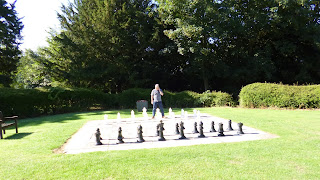Originally the "south end" of the village of Prittlewell, Southend became a seaside resort during the Georgian era attracting many tourists in the summer months to its seven miles of beaches and bathing in the sea. Southend is actually on the Thames Estuary not on the coast, and from the beach one can actually see Kent. Good rail connections and proximity to London mean that much of the economy has been based on tourism and that Southend has been a dormitory town for city workers ever since. There are nine railway stations on two lines within the borough which connect it to London.
The first thing we did when we arrived in Southend was to walk along the the promenade, here I am with the pier in the background.
Southend Pier is the world's longest pleasure pier at 1.34 mi (2.16 km). It has suffered fires and ship collisions, most recently in October 2005, but the basic pier structure has been repaired each time. Since 1986, a diesel-hydraulic railway has run the length of the pier, replacing the electric service which opened in 1890.
Southend, like many other British sea-side resorts, went into decline as a holiday destination from the 1960s, since flights and hence holidays abroad became more affordable. Since then, much of the town centre has been developed for commerce and retail, and during the 1960s many original structures were lost to redevelopment. However, about 6.4 million tourists still visit Southend per year.
We walked the length of the promenade and back up the other side, where we stopped for lunch of traditional fish and chips and a cup of tea (yes that's right tea not ale) at one of the many cafes offering the traditional British seaside fare. For some reason we didn't take many photographs at Southend but MWM did take this short video clip of the sea front so you can see what it's like.
The town is known for its seafront and attractions. An amusement park, formerly known as Peter Pan's Playground, straddles the pier entrance. Peter Pan's Playground was eventually renamed Adventure Island as its size and popularity grew, and has since grown with over 50 rides. MWM fancied going on one of the roller coaster rides but they are definitely not my cup of tea and he didn't want to go on his own so he gave it a miss. The seafront also houses the "Sea-Life Adventure"aquarium, owned by the Miller family, who also own Adventure Island.
The cliff gardens, which included Never Never Land and a Victorian bandstand were an attraction until slippage in 2003 made parts of the cliffs unstable, and the bandstand has been removed. The council wants to re-erect the bandstand but a location has to be found. Art on the Railings is a regular exhibition for local artists who display their work on Pier Hill and The London to Southend Classic Car run takes place each summer and features classic cars which line the seafront. The Southend Shakedown, organised by Ace Cafe, is an annual event featuring motorbikes and scooters. There are other scooter runs throughout the year, including the Great London Rideout, which arrives at Southend seafront each year.
A modern vertical lift links the base of the High Street with the seafront and the new pier entrance. The older Southend cliff Railway, a short funicular, is a few hundred metres away. We took the modern lift up to the new shopping area of of the town where we mooched around the shops and enjoyed the sunshine (it was a lovely sunny, warm day), then we found a bar where we enjoyed a pint of real ale, well it's thirsty work shopping isn't it?
All too soon it was time to head back to the seafront to meet our coach for the journey back to the hotel, where we had time for a short rest before getting ready for another delicious dinner and a relaxing drink on the hotel patio.
Next time we visit Colchester, I hope you'll join me.

















































